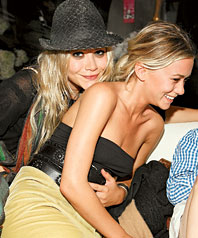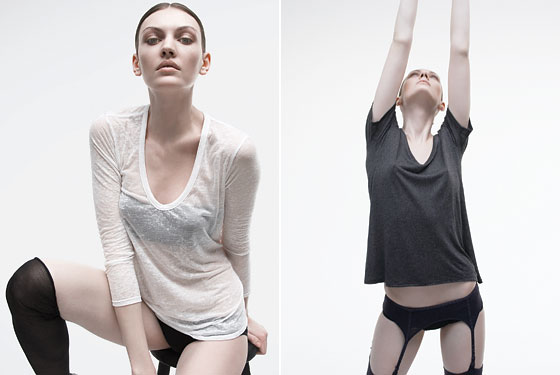
In the lobby of the Chateau Marmont, right on time, Mary-Kate Olsen is a kind of uncanny, elfin apparition. She’s wearing gobs of eyeliner, platform alligator stiletto heels, and a black wool coat buttoned up to her neck. She looks like a cross between J.T. Leroy, Wednesday Addams, and one of those big-eyed waifs from Margaret Keane paintings. She is fragile and goth, her tiny fingers covered in rings. She’s both glamorous and bohemian, eccentric and studied, and once she enters the room, it’s sort of impossible to look away. Her look—both an unmistakable signature and a kind of disguise—has been so widely emulated that it’s stunning to see the original in action.
Mary-Kate Olsen and her twin sister, Ashley, have been famous their entire lives. They are the rarest of child stars in that they have not grown up ugly, angry, or (it seems) insane. They’ve maintained their preadolescent adorability, with round eyes and faces and little button noses, and they’ve also maintained their mind-boggling fortune. When they were infants, they were cast in the single role of Michelle Tanner, the wisecracking baby of the Full House family. Little girls went mad for Michelle, madder still when it was discovered there were two of them, and their parents eventually figured out that this was a gold mine. With their then-manager, Robert Thorne, they co-founded Dualstar Entertainment, a business with the singular goal of leveraging the popularity of these two live Kewpie dolls. Before long, the Olsens were doing megabusiness in straight-to-video movies, and TV shows with names like Mary-Kate and Ashley in Action! Puppy Love, and licensing their names to cheap and cheerful lines of furniture and clothing for tweens—that is, girls age 5 to 12. Dualstar is now America’s number-one-selling brand in a number of categories: It’s the top fashion and lifestyle brand for girls and the number-one girls’ video franchise of all time. Books about the Olsens’ adventures have sold 40 million copies. In 2005, on the girls’ 18th birthday, they assumed decision-making, leadership roles at Dualstar; at that point, the company was doing $1.2 billion in sales a year. It sold the Olsens as wholesome and bright, accessible and mainstream. But their lives have become so much more sophisticated and complicated than their products. They have been selling Formica bedroom sets in pastel colors, but they worship Ghesquière.
This season, their contradictions resolve. They have just launched the Row, a line far more about who they’re becoming as adults than who they’ve been, in the eyes of the world, for such a long time.
It’s not the usual thing for celebrities of any age to actually have style, personal style, that is unique and individual and achieved on their own. But the Olsens, love it or hate it, do have style; they have it in buckets. While they have stopped with the corny matching outfits, their looks have developed as jarring mirror images of one another; they still exist in a little world of two. But there are subtle differences: Mary-Kate might wear ten kooky rings, Ashley just two or three. But, as Mary-Kate puts it: “If I sleep over at my sister’s, I can definitely get dressed from her closet in the morning.” Their signature look mixes Edie Beale with Balenciaga, Johnny Depp, and John Galliano. They don’t wear clothes that are conspicuously slutty or sexy or easy to predict. Even though supermarket tabloids condemn them to worst-dressed lists, fashion people are obsessed with their arms-open embrace of the industry’s avant-garde. They experiment with proportion and silhouette. They mix vintage and new, labels and non. They’ve raised accessorizing to a form of high, glamorous art. If the Olsens’ style resembles anyone at all, it’s not Lindsay Lohan or Mandy Moore or any of their other presumptive peers—they dress like sittings editors at French Vogue.
Mary-Kate and Ashley prefer to do their interviews separately these days. It’s part of a protracted maturation that really began during the two years they spent in New York as students at NYU. “We got this huge apartment and designed it,” Ashley says, “and then we never moved into it because we decided to live apart, and it was the best decision we ever made.” They explored separate interests: architecture for Ashley, photography for Mary-Kate. But where they met then, and still meet now, is at fashion, and that’s what they’re here to discuss.
The Row consists mainly of expensive knit T-shirts with fancy French seams, and a few minimalist separates, like a well-cut blazer and a tight, banded miniskirt in the style of Hervé Léger. Conspicuous flash is in the fur coats, which are oversize, luscious, but still somewhat plain. Unlike with their licensed collections, Mary-Kate and Ashley are hugely involved with the Row’s design process from start to finish, working in close tandem with a designer. The palette is as minimal as the collection: black, white, cream, gray, the occasional shot of red, and the label itself, a small, easy-to-miss gold chain embossed THE ROW. It’s like the Olsens themselves in its simultaneous desire to be both noticed and hidden.

‘I grew up horseback riding,” Mary-Kate says, lighting the first of what will be many Marlboro reds. “I never even picked up a fashion magazine when I was a kid.” But she did like fashion, and marvels with gaspy teenage incredulity over the dress code at her high school (khaki pants, collared shirts, closed-toed shoes), which, so she figures, was what first inspired her to look less like everyone else.
Mary-Kate’s first show was Marc Jacobs. Then there was a trip to Paris: Balenciaga, Christian Dior, French Vogue editor Carine Roitfeld. “When I really started looking at fashion, I was amazed,” she says. She claims to have arrived at her vampiric European look through a series of accidents. There was the giant-sweater boho era of her (short-lived) NYU career—“I was just trying to stay warm!” She also insists she was trying to be somewhat inconspicuous on her way to class, but the heaped-on layers, the giant sunglasses, the hunormous lattes had quite the opposite effect. Every other starlet was showing oodles of flesh, and here was this little gremlin buried in a massive hat. How not to be intrigued?
Mary-Kate left NYU (she’s still enrolled and has just a year and a half to go) because she didn’t feel safe, she says. She was freaked out by the kids in her class who were selling anecdotes to tabloids, in some cases even getting school credit for it. “They’d have internships at the weeklies,” she says, adding, “Learning is not fun if you’re not safe.”
Mary-Kate’s style has evolved since then. Fashion followed her into big coats and glasses, so now she is going small, dressed today in a tiny knit black dress and well-fitted coat.
The Row, she says, “was my sister’s baby, and of course I wanted to do whatever I could to help her.” She suggested additions to the line, like oversize man-tailored pants.
Both Olsens insist that they don’t shop much. They like simple, somewhat anonymous pieces and loads of accessories. “I love how you can totally change your look by changing your shoes,” Mary-Kate says, and pauses. “Or maybe you don’t look different, and no one else thinks you look different, but I feel different, anyway.” She laughs the crinkly-nosed, squinty-eyed chipmunk laugh that made her a tween queen, and then announces that she’s off to an audition. “I’m so sorry,” she says a few times, and then she’s gone.
Ashley arrives next, tottering across the garden on her own crazy, crazy shoes: They are sandals, platforms, stilettos all at once. Ashley is still tiny but somehow more robust than her sister. She was born first, is maybe two inches taller, and her bearing is far more alpha than Mary-Kate’s. Her look is somehow sleeker—giant Christian Dior shades, tight, narrow rubber pants, a tiny leather jacket with little ruched sleeves. Where Mary-Kate takes her soy latte decaf, Ashley asks for a double shot.
Within seconds of sitting (and lighting her Parliament Light), she’s talking business. “This is hands-on,” she says. “It’s production, it’s planning, it’s taking the right steps. It’s everything you need to do to start a business.” She looks like something from a cartoon, but she talks like she’s just stepped out of a Joan Collins boardroom scene.
The Olsens have been businesswomen for years, vetting their merchandising deals at Wal-Mart and elsewhere. But their work —in both fashion and “film”—has never been exactly a reflection of who they were or the adult lives they’d been leading. “When we were growing up, it was always about being appropriate,” Ashley says of the years spent in matching floral party dresses and silly sailor hats. And that’s what their Wal-Mart line reflects. But they’ve grown up to be something other than mainstream and appropriate. College taught Ashley what she wanted to do, but, as is so often the case, inadvertently. “I was studying architecture and psychology and I loved it, but I kept thinking about T-shirts and how to make the perfect one. It was my dad who said, ‘You should do it.’ ”
So she called a childhood friend, a designer named Danielle Sherman, and got to work. “That’s what I’m good at,” she says. “Seeing voids.” Ashley says she left NYU because she was ready to do the Row. “Wal-Mart was about the customer,” she says. “It taught us how to be commercial. This is about me and my sister, and what we like to wear.”
The Olsens are aware that their fame, so useful at Dualstar, is liable to be a hindrance with their new line—fashionistas won’t fall over each other to buy $150 T-shirts from a young-adult brand. So the Olsen name appears nowhere on the product, and they won’t be photographed in its promotion.
Whether the Row will attract the customers who buy Alaïa and Ghesquière is an open question. But the clothes do, in fact, stand on their own. They are sophisticated, elegant, versatile, understated. In a way, it’s a different tween act—idols to both goofy little girls and snotty fashion ladies. And for all their riches, it’s what they wanted. “I think,” says Mary-Kate, “my sister would be happy selling it out of the back of her car.”